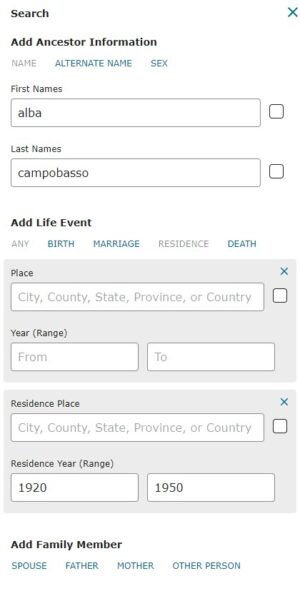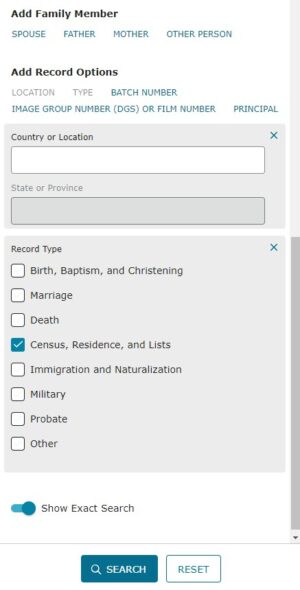Genealogists get a gift once a decade. Every ten years, the federal government takes the census, and 72 years later they release the full results to the public for use in genealogy research.
Most people only remember the census as the time when the government asks us how many toilets we have etc. Most of us will probably not live long enough to see those census returns 72 years later. But last year we were given our decennial gift: the 1950 U.S. Census.
When I started genealogy in the 1990s, there was basically no internet, and the census records certainly were not searchable on-line. We had to search a soundex microfilm, looking only for the head of household. The problem with that, among many, was that the father and mother of a family might not necessarily be the head of that household. They might have lived with a sibling and their family, or still with their parents. The way Italian families stay close together, sometimes in the same multi-floor apartment building, there’s no way to tell who is the head of household as far as the Census is concerned. And if you had a relative who was lodging with some cousin, or with no relative in particular, you might never be able to guess the head of household.
Fortunately, in the era of the internet, the census is indexed for everyone, and you can search by name, regardless of who was the head of household.
I do not have the scientific data to back this up, but I have noticed that a lot of families where both the father and mother were born in Italy, well, they managed to miss the 1950 census. This is by no means true of everyone, but frequently the same families who appeared in the US 1940 census are missing from the 1950, which is frustrating for us researchers. It could be fear of deportation. Who knows. I have not noticed this pattern with Italian families where both parents were born here. Just don’t be surprised if you don’t find someone who you know for certain was living in Chicago.
On FamilySearch, you can search just for the 1950 census, or you can search censuses with a range of years. For example, you can search for the name using the wild cards (? For one character, * for multiple characters) as I have discussed in many columns. So far, I have found most Italian surnames spelled the way they are spelled in America. First names depend on how recently they arrived. More recent immigrants will be “Giovanni” and the ones whose families came early in the 20th century are “John”, for example.
 The keys to searching for 1950 census records are to use the “Type” tab and click the box “Census, Residence and Lists”, and to use the “Residence” tab. You can choose to put in “Illinois” or “Chicago” if you want, or you can leave it blank. In the year, you can put “1950” to “1950” to focus only on the most recent census available to us, or you can put “1920” to “1950” or any other range of years. Please do not leave these years blank, because you will get a lot of residential databases that have nothing to do with the census, and will clutter your search results. Best bet: use 1950 to 1950.
The keys to searching for 1950 census records are to use the “Type” tab and click the box “Census, Residence and Lists”, and to use the “Residence” tab. You can choose to put in “Illinois” or “Chicago” if you want, or you can leave it blank. In the year, you can put “1950” to “1950” to focus only on the most recent census available to us, or you can put “1920” to “1950” or any other range of years. Please do not leave these years blank, because you will get a lot of residential databases that have nothing to do with the census, and will clutter your search results. Best bet: use 1950 to 1950.
If you have a name that has too many search results, you can use the Residence Place “Illinois” to get those New Yorkers out of the search results. (For that matter, the New Yorkers using this site can use Place “New York” to leave us Illinoians out!) You can also select the “Spouse”, “Mother”, or “Father” tabs to limit the search to only “John Lagioia” whose spouse is “Maria”. (Search tip for Mary/MaryAnn/Maria: just type MAR* which covers them all.)
 Keep in mind that searching for John Lagioia, whose father is Vito, will only find John if Vito is in the same residence as his son. If he lives next door, the search for John will not find him. The census only knows relationships if the people live in the same residence. It doesn’t know that John’s father happens to be Vito who died in the old country. So basically I am suggesting you can search for a person with the spouse because they live in the same residence.
Keep in mind that searching for John Lagioia, whose father is Vito, will only find John if Vito is in the same residence as his son. If he lives next door, the search for John will not find him. The census only knows relationships if the people live in the same residence. It doesn’t know that John’s father happens to be Vito who died in the old country. So basically I am suggesting you can search for a person with the spouse because they live in the same residence.
You may run into some issues while searching. One issue is the surname of a child who was born out of wedlock. I know this kid, now in his 70s, as “Ryan Giannini” (not his real name, of course) but at the time of the 1950 census he had his mother’s maiden name. She had not married Mr. Giannini yet. So if I searched for Ryan Giannini, he won’t be found. I had to search for Ryan Rutigliano to find him.
Another issue is handwriting. Census records were written as they went along the streets. Nothing is typed. So you have to put up with some bad cursive handwriting. I have had particular trouble with “a” and “o” being swapped, and lots of trouble with lower case “z”. When written in cursive, people read a “g”, “p”, or “f” sometimes.
A third issue is the family that straddles the census page.
Huh?
We have a family that starts on line 27, father Joseph Fornelli, 28 Mother Maria, 29 Son Pasquale, 30 daughter Filomena, and the page runs out of room. So daughter Nancy is on line 1 of the next page, and son Ronny is on line 2. When you search for these family members, you could click the “Father” tab and put “Joseph”, but you might not find Nancy Fornelli as the daughter of Joseph because they are on a new page. You would have a better chance of finding her by searching for her without her father. If you find Joseph’s page, and it goes to the 30th line, you should always go to the next page to see if there are any more people. The first page will have a check box that says “Household continued on next sheet” but check it anyway whether this box is checked or not.
Next month, we should look at what you can expect to find on the 1950 census page, compared to the 1940.
 Fra Noi Embrace Your Inner Italian
Fra Noi Embrace Your Inner Italian







Am doing my genealogy in Cape Town, South Africa. Am only 1/4 Italian. My father’s mother, nee Fiorina Allorto, was born in Pretoria. Her parents were Onorato Allorto and Theresa Corso from Biella. Married in South Africa, 2 daughters, grandmother married an Irishman from Killarney – 3 sons. O’Meara.
Allorto and 3 brothers fled risk of execution by nazis and came to South Africa. He had been an equestrian Alpini in the foothills patrols. Am reading about the Alpini a lot. All the Alps and snow and warfare is so different and unusual. Few people ever have the rare opportunity to encounter equestrian Alpini leagues, which is very secret . I am sad that this is the only time i will encounter this. Hope it remains part of me forever.